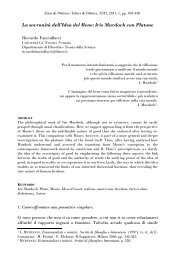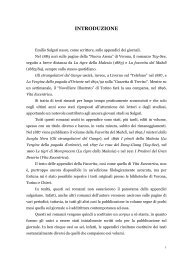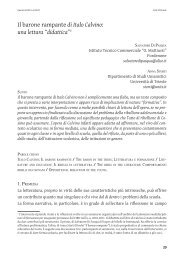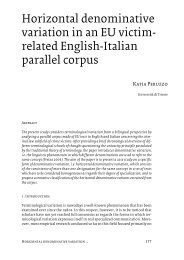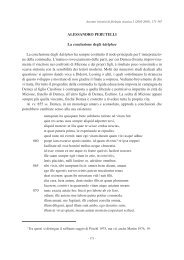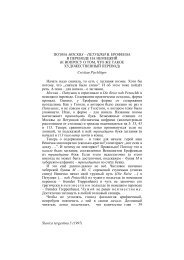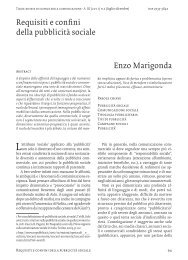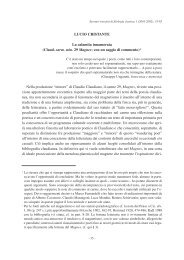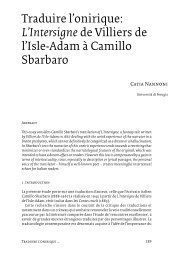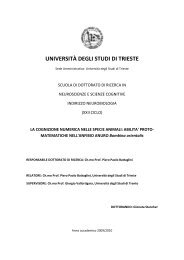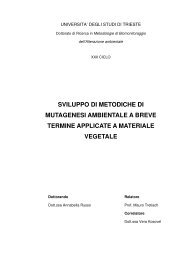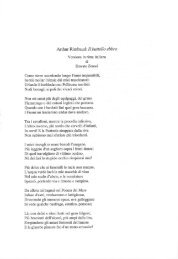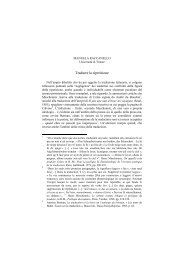Melchiorre Cesarotti e le trasformazioni del paesaggio ... - OpenstarTs
Melchiorre Cesarotti e le trasformazioni del paesaggio ... - OpenstarTs
Melchiorre Cesarotti e le trasformazioni del paesaggio ... - OpenstarTs
You also want an ePaper? Increase the reach of your titles
YUMPU automatically turns print PDFs into web optimized ePapers that Google loves.
That the meditations may verge upon the gloomy or e<strong>le</strong>giac was probab<strong>le</strong>, but<br />
not inevitab<strong>le</strong>, as Rousseau himself would show; if a country churchyard [Figure<br />
9] necessarily elicit thoughts of mortality, there were poets like Wordsworth<br />
who could attest to the p<strong>le</strong>asures of solitary meditations upon Immortality or the<br />
p<strong>le</strong>asures of simp<strong>le</strong> joyfulness in face of a bank of dancing daffodils. Furthermore,<br />
and again both Gray and Wordsworth provide good examp<strong>le</strong>s, these solitary<br />
strol<strong>le</strong>rs might well encounter indigenous persons, unspoilt children of the<br />
soil like peasants, but nothing quite as wild or terrifying as the bard.<br />
4. The landscapes of both bard and promeneur solitaire were not, however, topographies<br />
of social intercourse. Burke’s aesthetic category of the beautiful, in opposition<br />
to the private and often imaginary sublime, was a landscape of shared<br />
and communal experience. For this, obviously expansive activity, the landscaped<br />
garden and park were more suitab<strong>le</strong>, though obviously other sites could <strong>le</strong>nd<br />
themselves to social life. Groups could stroll and share conversations because<br />
the terrain was at its best designed precisely for these activities– paths wound<br />
through p<strong>le</strong>asant shrubbery or conducted visitors to moments of heightened appreciation,<br />
and along the way there might be inscriptions, statues, benches, temp<strong>le</strong>s,<br />
and a who<strong>le</strong> repertoire of fabriques designed to stimulate associations and<br />
promote discussions between the assemb<strong>le</strong>d persons [Figure 10].<br />
5. These three landscapes modes, or landscapes tastes, obviously had opportunities<br />
to elide, one into the other, especially when a designer sought to represent them<br />
within a sing<strong>le</strong> parkland, as that extremely inventive Franceso Bettini did in his<br />
project for Andrea Dolfin at Mincana. 20 By his own account, this attempt to include<br />
a variety of characteristic landscapes or what he termed «<strong>le</strong> scene di carattere» was<br />
offered in the interests of both «Novità” and «Bizzarria». It had e<strong>le</strong>ments of the<br />
sublime («un Deserto» with ruined buildings, and «una azione eroica”), melancholy<br />
à la Gray (with an «Isola de’ Sepolcri»), along with more bland and pastoral<br />
scenery, whi<strong>le</strong> around the mansion itself were clustered the more social sceneries.<br />
<strong>Cesarotti</strong>’s own parkland, Selvaggiano, also managed to impose a remarkab<strong>le</strong> agenda<br />
of effects onto a small site: these included a «stradoncino lugubre», a «boschetto<br />
funebre», a grotto and a hillock dedicated to Naiads, and many inscriptions. 21<br />
Other <strong>le</strong>ss ambitious combinations of landscapes did get built: in some the social<br />
scene could <strong>le</strong>ad guests to places where the frissons of the sublime could be enjoyed,<br />
but always in the security of knowing that it was possib<strong>le</strong> to return to a shared<br />
20This This drawing, in the Doria Pamphili archives archives in Rome, is illustrated in L’Arte dei Giardini. Scritti<br />
teorici e pratici dal XIV al XIX secolo, ed. M. Azzi Visentini, 2 vols., Milan, 1999, II, p.117, and his<br />
text is reproduced on pp. 116-21.<br />
21 Items cited by A. Pietrogrande, Selvaggiano: il poema vegetabi<strong>le</strong> di <strong>Melchiorre</strong> <strong>Cesarotti</strong>, cit. (note 1).<br />
transformations in landscape circa 1800.<br />
13



